Lebanese cuisine
Lebanese cuisine (Arabic: المطبخ اللبناني) is the culinary traditions and practices originating from Lebanon. It includes an abundance of whole grains, fruits, vegetables, fresh fish and seafood. Poultry is eaten more often than red meat, and when red meat is eaten, it is usually lamb and goat meat. It also includes copious amounts of garlic and olive oil, often seasoned with lemon juice. Chickpeas and parsley are also staples of the Lebanese diet.[1][2][3]
Well known savoury dishes include baba ghanouj, a dip made of char-grilled eggplant; falafel, small deep-fried patties made of highly spiced ground chickpeas, fava beans, or a combination of the two; and shawarma, a sandwich with marinated meat skewered and cooked on large rods.[4][5] An important component of many Lebanese meals is hummus, a dip or spread made of blended chickpeas, sesame tahini, lemon juice, and garlic, typically eaten with flatbread.[6][7][8] A well known dessert is baklava, which is made of layered filo (thinly rolled pastry) filled with nuts and steeped in date syrup or honey.[9] Some desserts are specifically prepared on special occasions: the meghli (rice pudding dessert, spiced with anise, caraway, and cinnamon) for instance, is served to celebrate a newborn baby in the family.[10][11]
Arak is an anise (aromatic spice) flavoured liqueur, and is the Lebanese national drink, usually served with a traditional convivial Lebanese meal. Another historic and traditional drink is Lebanese wine.[12][13][14]
History
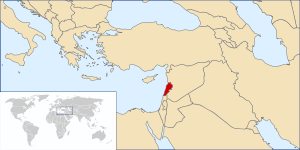
Lebanese cuisine is an ancient one and part of the cuisine of the Levant. Many dishes in Lebanese cuisine can be traced back thousands of years to eras of Roman, Greek, Persian, Byzantine, Arab, Egyptian, and Phoenician rule.[15][16] In the last 500 years, Lebanese cuisine has been influenced by the different foreign civilizations that held power. From 1516 to 1918, the Ottoman Turks controlled Lebanon and introduced a variety of foods that have become staples in the Lebanese diet, such as cooking with lamb. After the Ottomans were defeated in World War I (1914–1918), France took control of Lebanon until 1943, when the country achieved its independence. The French introduced foods such as flan, a caramel custard dessert dating back to the 16th century AD, eclairs, french fries and croissants.[17]
The Lebanese diaspora who live worldwide have introduced new ingredients, spices and culinary practices into Lebanese cuisine, keeping the cuisine innovative and renowned both beyond and within its borders.[18][19]
Overview
Most often foods are grilled, baked or lightly cooked in olive oil; butter or cream is rarely used other than in a few desserts. Vegetables are often eaten raw, pickled, or cooked. Like most Mediterranean countries, much of what the Lebanese eat is dictated by the seasons and what is available. Lebanese cuisine also varies by region. South Lebanon is famous for its kibbe, the Beqaa Valley for its meat pastries (such as sfiha), and north Lebanon and Saida (Sidon) for its sweets.[20][21]
In Lebanon, very rarely are drinks served without being accompanied by food. Similar to the tapas of Spain, mezeluri of Romania and aperitivo of Italy, mezze is an array of small dishes placed before the guests creating an array of colors, flavors, textures and aromas.[22][23] This style of serving food is less a part of family life than it is of entertaining and cafés. Mezze may be as simple as raw or pickled vegetables, hummus, baba ghanouj and bread, or it may become an entire meal consisting of grilled marinated seafood, skewered meats and a variety of cooked and raw salads and an arrangement of desserts. The assortments of dishes forming the mezze are generally consumed in small bites using a piece of flatbread.[23] A typical mezze will consist of an elaborate variety of thirty hot and cold dishes and may include:
- Salads such as tabbouleh and fattoush.
- Dips such as hummus, baba ghanoush and moutabal.
- Kebbeh, kafta and falafel (fried chickpea balls).
- Some patties such as the sambusac.
- Stuffed grape leaves and pickles.
- Roasted nuts, olives and vegetables.
- Condiments like toum and taratour, ideal for spread on sfiha.[23][24][25][26]
When dining as a family, the mezze typically consists of three or four dishes, but when served in the restaurant, the mezze can range from twenty to sixty dishes, as the variant combinations and dishes involved are plenty.[27] Family cuisine also offers a range of dishes, such as stews (yakhneh) which can be cooked in many forms depending on the ingredients used and are usually served with meat and rice.[28][29]
Although simple fresh fruits are often served towards the end of a Lebanese meal, there is also dessert, such as baklava and coffee. When sweets are not available, fruits are typically eaten after meals, including figs, oranges and other citrus fruits, apples, grapes, cherries and green plums (Janarek).[30][31] Although baklava is the most internationally known dessert, there is a great variety of Lebanese desserts.[32]
Dishes and ingredients
Lebanese dishes are heavily influenced by the multiple civilisations that have existed within the region, especially the Arab-Muslim contribution, which has accumulated together to form the modern Lebanese cuisine we know today. Using fresh, flavourful ingredients and refined spices, the Lebanese combine the best of Turkish and Arab cuisine with a French twist. This is especially noticeable in the prevalence of the use of the lamb (introduced by the Ottomans), the abundant use of nuts, especially almonds and pine nuts, and dressings made from lemon juice.[33]
Bread
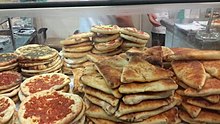
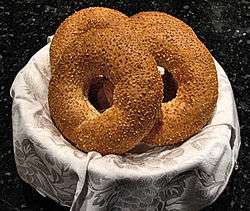
The Lebanese use bread as an integral part of a meal and food is generally not served without it.[34]
Khubz is a round flatbread baked in a mud oven. It can be used in almost all kinds of Lebanese dishes.[35] Similarly, taboon bread is traditionally baked in a taboon oven or a tannur, and is similar to the various tandoor breads found in many parts of Asia.[36] Marquq is a similar bread to khubz, but is prepared much thinner, almost paper thin.[37][38]
Manaeesh (mini pizza) traditionally garnished with cheese (kashk in its Lebanese version), za'atar, spicy diced tomatoes and may be eaten for breakfast. These are made in many variants in any number of local bakeries or Furns (Furn Assalam, Ain El Hilwe, Saida), Some bakeries allow customers to bring their own toppings in order to build their own customized manaeesh for breakfast, lunch, and dinner.[39] Variants include manakousheh zaatar (thyme pizza) and manakousheh jebneh which has only cheese.[40][41] Manaeesh can also be eaten with minced meat and onions.
Ka'ak is another common Lebanese street bread that is usually consumed as a snack. There are many variations of ka'ak, from being sprinkled with traditional sesame seeds on top, to being stuffed with cheese and zaatar.[42]
Dairy
Cheese is common in Lebanon and the traditional cheeses originate from all over the world. Along with cheese, yogurt and eggs are commonly utillized. One of the more recognizable dishes within Lebanon is the yogurt labneh. It is different from regular yoghurt in that it's been strained so as to remove the watery whey, leaving a thicker, creamier consistency. It is spreadable and garnished with good olive oil and sea salt.[43] It can be seen served in a mezze platter for breakfast and dinner. Such is the versability of this dish. A variant of this, labneh bi toum is mixed with garlic.[43]

Ackawi (also akkawi), named after the city Acre (Akka in Arabic) is a salty white cheese made from pasteurized cow's milk but can also be made with goat or sheepmilk.[44] Halloum (originally from Cyprus) is a semi-hard unripened cheese, perfect for grilling and frying. Along with akkawi, these are traditionally stored in brine giving them a strong, salty taste, however modern methods have allowed a variety to be sold fresher with moderate salting.[45]
.jpg)
Nabulsi, also spelled Naboulsi (from the city Nablus), is similar to halloumi and is made by boiling fresh ackawi cheese in a mixture of spices and seeds to be fried, grilled or eaten and is used in the important and integral dessert, knafeh, a cheese pastry soaked in a sugar based syrup.[46]
Feta (from Greece) is used in salads and other dishes, although some cooks will use a milder cheese called jibtieh baidha (simply "white cheese").[47][48] Kashkaval is another European cheese popular in many Eastern European countries that has made its way into Lebanese cusine. It melts very quickly and is practical for pasta, pizza and sandwiches.[49]
Another popular cheese, shanklish, is made from cow's milk which is salted, fermented and seasoned with thyme and pepper and formed into cheese balls, coated in red pepper chilli flakes.[50]
Ejjeh is the traditional omelette of Lebanon. It is made with egg, chopped parsley and scallions. Within Lebanon, people make this omelette with different herbs that are cultivated from their village.[51][52]
Stews
Lebanese stews, often served with rice or flatbread, are prepared in many varieties depending on the accessibility of various ingredients.

Okra and tomato stew (bamieh bi-zeit) is one of the most popular. Traditionally it's served with rice and a basic salad dressed with lemon juice and olive oil, with fresh warm bread.[53] This stew combines the distinct flavor of okra with a flavourful tomato sauce.[54] A alternative version to this, bamya bel lahmeh adds small pieces of fillet lamb or beef that have been sautéed beforehand to avoid a boiled taste.[55]
Bean stews are commonplace due to the accessibility of various beans grown. A example of a mixed bean Lebanese stew is makhlouta which is prepared with a variety of beans, wheat, and legumes and is popular in the town of Baskinta.[56] Others include fava bean stew, kidney bean stew (fasoulya hamanieh) and another kidney and lentil stew called mjadrat fasoulya popular in Rashaya.[57] Taro and lentil stew (abu shoushe) and spinach stew (yakhnet sabanikh) are a few more of the many different stews available.[58][59][60]
Mulukhiyah is a stew with mallow leaves, chicken, beef, and in the Lebanese fashion, topped with raw chopped onions, and vinegar.[61] In northern Lebanon, a similar dish to Mulukhiyah is called mloukhiye b'zeit. it is made using fresh leaves and shoots of the Nalta jute plant, cooked in olive oil, onions, garlic, tomatoes and chilli peppers; it is a popular summer side dish, especially in Miniyeh-Danniyeh and Akkar districts. In summer one of the easiest and simplest ways to make use of the abundant summer zucchini is Mfaraket Koussa (spicy zucchini stew).[62][63]
Daoud bacha, another meat-based stew consists of beef meatballs (also lamb) with cinammon, parsley and stuffed with pinenuts in a tomato sauce.[64]
Vegetarian
Vegetarian cuisine plays an important, and specific role in the cuisine of Lebanon. Being located in the Levant, vegetables and herbs (wild or cultivated) are abundant in the fertile landscape and serve as a main base of the cuisine.[65] Some of the most popular street foods in Lebanon are vegetarian including fava beans, hot roasted peanuts served in a paper cone, prickly pears (served peeled and on ice), ful medames (fava beans) and balila (chickpeas seasoned with cumin).[66]
Nearly everything can be cooked either with meat or b’zeit (oil), from beans to fish, stews and spinach. Meat was traditionally precious and usually served on a Sunday, but was expensive and usually eaten with bulgur or rice to prolong the shelf life. For Lebanese Christians, including Catholic (Maronites and Melkites) and Orthodox, fasting from meat is practiced over the Lenten period (from midnight to noon) during Easter. Where abstention of meat is observed, the food is referred to as 'akl aateh' (meaning food "cut" from the diet, such as meat or absent from meat), the particular food that is "cut" varies over different traditions.[67]
Salads

Fattoush (also called "peasants' salad") is made with khubz flatbread, cucumbers, tomatoes, chickweed, and mint. Tabbouleh is a diced parsley salad with burghul wheat, tomato, mint and served with lettuce, eaten within a mezze or as a standalone dish as a precursor to a main course.[68][69] Yogurt cheese salad consists of shanklish balls (yogurt cheese, feta, chilli powder, thyme, cumin, salt and pepper) added to a freshly prepared salad. It is distinctively Lebanese as is a perfect addition for mezze, complimenting arab and Lebanese wines.[70]
Stuffed dishes
Wara' Enab is a dish commonly served as a mezze (appetizer) and is stuffed with either rice and meat or just rice.[71] Another stuffed dish kousa mahshi consists of various kinds of squash or zucchini stuffed with rice and sometimes meat and cooked on the stovetop or in the oven.[72]
Chickpea-based dishes
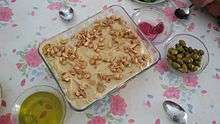
Chickpea dishes include falafel (deep-fried patties made of highly spiced ground chickpeas), hummus (a popular dip for pita bread made of blended chickpeas, sesame tahini, lemon juice, and garlic) and its variants including, Hummus Ras Asfour (with meat on top) and Fateh b'hummus, (a chickpea and spiced yogurt dish).[73]
Balila (cumin chickpeas), is a simple yet popular Lebanese dish that has been boiled along with lemon juice, garlic and various spices.[74]
Aubergine-based dishes
Aubergine dishes are common in Lebanon. They include well known dishes such as baba ghanouj (a char-grilled aubergine, made with tahina, olive oil, lemon juice, and garlic puree), mutabbel (mashed cooked aubergines and tahini, mixed with salt, pepper, olive oil, with anar seeds) and makdous, a stuffed eggplant dish served with olive oil.[75][76] Fried aubergine is also served alongside other fried vegetables including potatoes, courgettes onions and tomatoes. Usually referred to as a "mixed fry up".[77] One of the most popular dishes in the Levant is fatteh and the popular variant fatet batinjan (eggplant casserole) is served with yoghurt, fried bread and aubergine, served with mate.[78][79][80] Unlike the Greek style, Lebanese moussaka is a vegetarian eggplant dish, made with fried eggplant simmered in an onion and tomato sauce with chickpeas.[81]
Bean and legume dishes
Lebanese style ful (cooked fava beans) is a slow cooked mash of brown beans and red lentils dressed with lemon, olive oil, cumin and is best served with various vegetables and pita/khubz.[82] Riz bil-Foul is another dish with fava beans, seasoned with various spices and served with rice.[83] Mujaddara (imjaddarra) is a popular dish found throughout the Middle East and consists of cooked lentils together with wheat or rice, garnished with onions that have been 'sauteed' (lightly cooked in vegetable oil).[84]
Meats
Lebanese meat dishes are usually made with chicken or lamb, though pork is also eaten (albeit not as widely, due to Islamic dietary laws).[85] However, meat is expensive everywhere and not always readily available. Dehen, somewhat like a meat shortening made from lamb suet, fried lamb pieces and spices, is often used to give dishes a light meaty flavour without the expense of bulk meat.[86] Habra (raw lamb fillet) is essential for most dishes involving lamb. It is the foundation for many popular dishes including habra nayeeh (raw lamb with onion), kibbeh nayyeh (raw kibbeh), kafta nayyeh (raw beef tartarre) and others including variants of kibbeh. The fillet needs to be prepared and chilled for a minimum of 2 hours, and can even be prepared one day in advance.[87]
Mixed meat
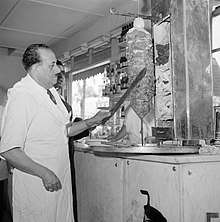
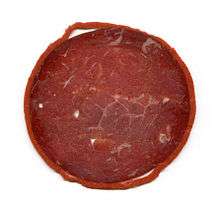
- Shawarma is a commonly found form of street food made with slow-cooked skewered meat (either chicken or lamb) that is thinly sliced and served as a sandwich with toppings such as onions, pickles and tomatoes.[88][89] Styles of this dish include shawarma lahmeh, grilled meat with parsley, onion and tarator and shawarma djeij which is grilled poultry with toum and lettuce.[90]
- Sambousek (also called samboosak, or sambousak bi-lahm) is a small stuffed pastry often filled with meat and served as an appetizer (mezze). Though usually filled with ground beef or lamb, sambousek can also be filled with cheese or other fillings.[91][92]
- Kibbeh is a filled bulgur dough made with ground meat and can be made in different forms including fried (Kibbeh raas), uncooked (kibbeh nayyeh), baked (kibbeh bil-saneeya), and all may be served with yogurt.[93][94][95] Some regional versions of kibbeh are a pumpkin-flavoured kebbe lakteen (popular in Beit Mery) and kebbe zghartweih which is a oven-cooked version popular in Ehden.[96][97]
- Kubideh is a type of kebab served with pivaz, a relish made of minced parsley, onions, ground cumin and sumac.[98]
- Kafta is made with spiced ground meat that is shaped into small patties or rolled into meatball-shaped balls which are then baked, pan-fried or charcoal-grilled on skewers. Kafta is served with bread and other side dishes.[99]
Lamb
- Barout del batata – spicy lamb served with potatoes.[100]
- Deleh mehshi – stuffed rib cage of lamb (popular in Broummana).[101]
- Laban Immo – cooked yoghurt and lamb with rice (popular in Douma).[102]
- Kafta meshwi – minced lamb mixed with finely chopped onion and parsley, broiled on a skewer over charcoal.[103]
- Qawarma – originates from a centuries-old custom that was to buy a fat-tailed lamb in the spring and force-feed it day and night with mulberry and grape leaves, wheat hulls and other ingredients ending in a succulent chopped lamb dish, salted and kept in the grease of the animal.[104][105][106]
- Lahm bil ajĩn (or Sfiha) – a pastry covered with mutton minced meat, onions, and nuts from the Lebanese town of Baalbek.[107][108]
- Shish barak (Lebanese ravioli) – meat dumplings in yogurt sauce.[109]
- Khash – boiled sheep parts, which might include the head, feet, and stomach (tripe).
Chicken
- Chich taouk – charcoaled grilled chicken marinated with garlic lemon and various oriental spices (cinnamon, cumin...)[110]
- Djaj meshwi – grilled, spiced mildly chicken on bbq marinated with a garlic lemon sauce.[111]
- Farrouj meshwi – grilled chicken, served with garlic sauce.[112]
- Jwenih (or Jawaneh) – chicken wings cooked with coriander, garlic and lemon, served as mezze.[113]
- Riz bi-djaj – chicken and rice.[114]
- Shish taouk – grilled chicken skewers that utilize only white meat, marinated in olive oil, lemon, parsley, and sumac, served on a bed of rice with almonds and pine nuts.[115]
Beef
- Pastirma – cured, seasoned dried beef, introduced by the Ottomans.[116][117]
- Tabbouleh bi dehn – another version of tabbouleh and is cooked with lentils and beef ghee.[118]
- Ghameh – a delicacy of stuffed cow intestines.[119]
- Kafta bithine – spiced meat with sesame concentrate, popular in Beit ed-Dine.[120]
Fish
- Samkeh harra – grilled fish that has been marinated with chili, citrus, and cilantro.[121]
- Akhtabout – grilled octopus (usually served with Samkeh Harra in Beirut).[122]
- Siyyadiyeh (or sayadiyeh) – delicately spiced fish served on a bed of rice. Fish cooked in saffron and served on rice with onions, sumac, and a tahini sauce (the most important part of the dish) originated in Sidon.[123]
Sweets
The modern form of Lebanese desserts have been influenced by Ottoman cuisine and share many similarties with other neighbouring countries.
Muhallebi is a milk pudding made with rice, milk and sugar. Like many other Lebanese desserts, it is sweetened with atar syrup and served with a garnish of assorted nuts.[124]
Barazeh, also found in Syrian cuisine, are cookies with a light and crumbly texture; one size is decorated with sesame seeds and the other pistachio. Ma'amoul are crumbly cookies filled with pistachio, walnuts or dates. Lebanese Christians serve ma'amoul with atar syrup for Easter, as well as a cake flavored with anise and mahlab.[124]
Pastry shops in Tripoli offer baklava along with other local specialty pastries like halawet el jibn, filled with sweetened cheese and topped with atar, pistachios, clotted cream (ashta) and rose jam. Baklava is made of a layered pastry filled with nuts and steeped in attar syrup (orange or rose water and sugar), usually cut into a triangular or diamond shape when served, which is the particular style that originated in Lebanon.[125] Znoud al-sit is a syrup-soaked rolled pastry filled with clotted cream and garnished in typical fashion with nuts, orange peels and dates to the 19th century.[124] Kanafeh is a dessert stuffed with white cheese (such as akkawi cheese), nuts and syrup made with made with kadayif dough.[126][127]
Semolina is used in the preparation of several Lebanese desserts like the pistachio-filled cookie karabij (or aleppo cookies), flavored with mahlab and cinnamon, topped with natef, which is similar to meringue. Mafroukeh is a semolina dough layered with caramel and butter, soaked in atar and served with clotted cream and assorted nuts. It can also be used to make cakes like nammoura.[124] Sfouf is a cake made with semolina flour and tumeric. It is cake consumed on birthdays, family reunions, and religious holidays.[128]
Lebanese ice cream is popular with its eastern flavors, including amar al-din made from dried apricot paste.[127]
Condiments and spices
- Tahini – sesame paste.[129]
 Sumac is a spice used in many salads, hummus and other dishes giving it a tangy, lemony taste
Sumac is a spice used in many salads, hummus and other dishes giving it a tangy, lemony taste - Tarator – cucumber, yogurt, garlic and lemon dip.[130]
- Toum – garlic sauce.[131]
- Sumac – a tangy spice used in many salads.[132]
- Za'atar – dried thyme and sumac that can differ from region to region and from family to family. Most are made in house, but can be bought at Lebanese larders.[133]
- Lebanese spice blend (also called Lebanese seven spice[134]) – a mixture of equal parts of allspice, black pepper, cinnamon, cloves, fenugreek, nutmeg and ginger. It is commonly used to flavor many Lebanese dishes.[135]
Beverages

- Arabic coffee, black coffee and Turkish coffee.[136][137].[138]
- Lebanese beer, also contains non-alcoholic versions made with malt instead of hops.[139]
- Arak – an alcoholic beverage.[140]
- Ayran – yogurt.[141]
- Non-alcoholic beverage made from the carob tree.
- Jallab – sweet drink made from carob, dates, grape molasses and rose water.[142]
- Lebanese wine – Lebanon is among the oldest sites of wine production in the world.[143] The Phoenicians of its coastal strip were instrumental in spreading wine and viticulture throughout the Mediterranean in ancient times. Lebanons Beqaa Valley contains more than 30 vineyards, including the renowned Kefraya, Ksara and Château Musar labels.[144][145]
- Mate – a caffeine-rich infused drink and is consumed frequently in Shouf and Aley. It was thought to have been brought from Argentina by immigrants in the Lebanese diaspora returning home, where its important ingredients are grown.[146]
See also
References
- Sheehan, Sean (September 1996). Lebanon. Marshall Cavendish. ISBN 978-0-7614-0283-1.
- Al-Faqih, Kamal (1 September 2009). Classic Lebanese Cuisine: 170 Fresh and Healthy Mediterranean Favorites. Rowman & Littlefield. ISBN 978-0-7627-5649-0.
- Laura, Perdew (November 2014). Understanding Lebanon Today. Mitchell Lane Publishers, Inc. ISBN 978-1-61228-676-1.
- Marlène, Dahlia & (27 November 2014). Lebanese Cuisine (in Italian). Edizioni R.E.I. ISBN 978-2-37297-134-8.
- Anderson, John J. B.; Sparling, Marilyn C. (6 June 2014). The Mediterranean Way of Eating: Evidence for Chronic Disease Prevention and Weight Management. CRC Press. ISBN 978-1-4822-3125-0.
- Al-Faqih, Kamal (1 September 2009). Classic Lebanese Cuisine: 170 Fresh and Healthy Mediterranean Favorites. Rowman & Littlefield. ISBN 978-0-7627-5649-0.
- Kayyali, Randa A. (2006). The Arab Americans. Greenwood Publishing Group. ISBN 978-0-313-33219-7.
- Saleh, Nada (31 March 2012). New Flavours of the Lebanese Table. Random House. ISBN 978-1-4481-1876-2.
- Al-Faqih, Kamal (1 September 2009). Classic Lebanese Cuisine: 170 Fresh and Healthy Mediterranean Favorites. Rowman & Littlefield. ISBN 978-0-7627-5649-0.
- Gall, Timothy L.; Hobby, Jeneen (2009). Worldmark Encyclopedia of Cultures and Daily Life. Gale. ISBN 978-1-4144-4892-3.
- Mouzawak, Kamal (15 September 2015). Lebanese Home Cooking: Simple, Delicious, Mostly Vegetarian Recipes from the Founder of Beirut's Souk El Tayeb Market. Quarry Books. ISBN 978-1-63159-037-5.
- Zurayk, Rami; Rahman, Sami Abdul (2008). From ʻAkkār to ʻAmel: Lebanon's slow food trail : places, products and producers from Lebanon. Slow Food Beirut.
- Kuntz, Blair (2000). Lebanon: an insider's guide. Prana Publishers.
- Karam, Michael (2008). Arak and Mezze: The Taste of Lebanon. Saqi Books. ISBN 978-0-86356-476-5.
- Edelstein, Sari (2011). Food, Cuisine, and Cultural Competency for Culinary, Hospitality, and Nutrition Professionals. Jones & Bartlett Learning. ISBN 978-0-7637-5965-0.
- DeMeester, Fabien (23 January 2008). Wild-type Food in Health Promotion and Disease Prevention: The Columbus Concept. Springer Science & Business Media. ISBN 978-1-59745-330-1.
- Choueiri, Ramzi N. (1 January 2002). The Culinary Heritage of Lebanon. Ramzi Choueiri. ISBN 978-9953-0-0753-3.
- Hannam, Kevin; Mostafanezhad, Mary; Rickly, Jillian (17 March 2016). Event Mobilities: Politics, place and performance. Routledge. p. 136. ISBN 978-1-317-45047-4.
- Food, Lonely Planet (1 August 2012). The World's Best Street Food: Where to Find it & How to Make it. Lonely Planet. ISBN 978-1-74321-664-4.
- Sageer, Julie Ann; Bhabha, Leah (6 June 2017). Julie Taboulie's Lebanese Kitchen: Authentic Recipes for Fresh and Flavorful Mediterranean Home Cooking. ISBN 9781250094940.
- Lebanon Through the Lens of Munir Nasr. ISBN 9789953003450.
- Walker, Harlan (2002). The Meal: Proceedings of the Oxford Symposium on Food and Cookery, 2001. Oxford Symposium. p. 268. ISBN 978-1-903018-24-8.
- Cavendish, Marshall (September 2006). World and Its Peoples. Marshall Cavendish. p. 979. ISBN 978-0-7614-7571-2.
- Rombauer, Irma S.; Becker, Marion Rombauer; Becker, Ethan; Becker, John; Scott, Megan (12 November 2019). Joy of Cooking: 2019 Edition Fully Revised and Updated. Simon and Schuster. p. 46. ISBN 978-1-5011-6971-7.
- Atalla, Ina'am (14 August 2014). Simply Lebanese. Garnet Publishing Ltd. ISBN 978-1-85964-343-3.
- Sheehan, Sean; Latif, Zawiah Abdul; Schmermund, Elizabeth (15 April 2017). Lebanon. Cavendish Square Publishing, LLC. ISBN 978-1-5026-2601-1.
- Jousiffe, Ann (1998). Lebanon. Lonely Planet. ISBN 978-0-86442-350-4.
- Hamady, Mary L.; Laird, Mary Louise (1995). Lebanese Mountain Cookery. David R. Godine Publisher. ISBN 978-1-56792-020-8.
- Saleh, Nada (31 March 2012). New Flavours of the Lebanese Table. Random House. ISBN 978-1-4481-1876-2.
- Clark, Samantha; Clark, Samuel (1 May 2014). Morito. Random House. ISBN 978-1-4481-1758-1.
- Anderson, John J. B.; Sparling, Marilyn C. (6 June 2014). The Mediterranean Way of Eating: Evidence for Chronic Disease Prevention and Weight Management. CRC Press. ISBN 978-1-4822-3125-0.
- Hamadeh, Mona (2015). A Lebanese Feast of Vegetables, Pulses, Herbs and Spices. Little, Brown Book Group. p. 211. ISBN 978-1-84528-580-7.
- Marlène, Dahlia & (27 November 2014). Lebanese Cuisine (in Italian). Edizioni R.E.I. ISBN 978-2-37297-134-8.
- Cavendish, Marshall; Corporation, Marshall Cavendish (September 2006). Peoples of Western Asia. Marshall Cavendish. ISBN 978-0-7614-7677-1.
- Kopka, Deborah (1 September 2011). Passport Series: Middle East. Milliken Publishing Company. ISBN 978-1-4291-2261-0.
- Al-Khusaibi, Mohammed; Al-Habsi, Nasser; Rahman, Mohammad Shafiur (18 October 2019). Traditional Foods: History, Preparation, Processing and Safety. Springer Nature. ISBN 978-3-030-24620-4.
- Fawaz, Leila Tarazi (1 January 1994). An Occasion for War: Civil Conflict in Lebanon and Damascus in 1860. University of California Press. ISBN 978-0-520-20086-9.
- "About Lebanese Bread". ifood.tv. Retrieved 30 April 2020.
- Wells, Patricia; Loomis, Susan Herrmann (1999). The Food Lover's Guide to Paris. Workman Pub. ISBN 978-0-7611-1479-6.
- Marlène, Dahlia & (16 March 2017). Ethnic Cuisine - The Trilogy (in Italian). Edizioni R.E.I. ISBN 978-2-37297-335-9.
- "How to bake this Lebanese cheese flatbread". Middle East Eye. Retrieved 26 April 2020.
- https://www.tasteatlas.com/most-popular-street-foods-in-lebanon
- Encyclopedia of Dairy Sciences. Academic Press. 25 March 2011. ISBN 978-0-12-374407-4.
- Kehler, Mateo (2016). The Oxford Companion to Cheese. Oxford University Press. ISBN 978-0-19-933088-1.
- Wood, B. J. (6 December 2012). Microbiology of Fermented Foods. Springer Science & Business Media. ISBN 978-1-4613-0309-1.
- Tamime, Adnan Y. (15 April 2008). Brined Cheeses. John Wiley & Sons. ISBN 978-1-4051-7164-9.
- Jenkins, Nancy Harmon (27 March 2012). The New Mediterranean Diet Cookbook: A Delicious Alternative for Lifelong Health. Random House Publishing Group. ISBN 978-0-345-53614-3.
- Uvezian, Sonia (2001). Recipes and Remembrances from an Eastern Mediterranean Kitchen: A Culinary Journey Through Syria, Lebanon, and Jordan. Siamanto Press. ISBN 978-0-9709716-8-5.
- Al-Faqih, Kamal (1 September 2009). Classic Lebanese Cuisine: 170 Fresh and Healthy Mediterranean Favorites. Rowman & Littlefield. ISBN 978-0-7627-5649-0.
- Sageer, Julie Ann; Bhabha, Leah (6 June 2017). Julie Taboulie's Lebanese Kitchen: Authentic Recipes for Fresh and Flavorful Mediterranean Home Cooking. St. Martin's Publishing Group. ISBN 978-1-250-09494-0.
- Osborne, Christine (1985). Cooking the Middle Eastern Way. Chartwell Books. ISBN 978-0-89009-838-7.
- "Ejjeh Classic Lebanese Egg Omelette". Patty's Food Fare. Retrieved 26 April 2020.
- "Bamieh bil Lahme | The Elegant Economist". 16 December 2019. Retrieved 3 August 2020.
- "Okra Stew". Simply Lebanese. Retrieved 30 April 2020.
- "Lebanese Okra Stew with Lamb (Bamia Bi Lahme) by Zaatar and Zaytoun". Zaatar & Zaytoun. 2 March 2020. Retrieved 5 May 2020.
- Mouzawak, Kamal (15 September 2015). Lebanese Home Cooking: Simple, Delicious, Mostly Vegetarian Recipes from the Founder of Beirut's Souk El Tayeb Market. Quarry Books. ISBN 978-1-63159-037-5.
- Edelstein, Sari (2011). Food, Cuisine, and Cultural Competency for Culinary, Hospitality, and Nutrition Professionals. Jones & Bartlett Learning. ISBN 978-0-7637-5965-0.
- Accad, Joumana (2 September 2014). Taste of Beirut: 175+ Delicious Lebanese Recipes from Classics to Contemporary to Mezzes and More. Health Communications, Inc. ISBN 978-0-7573-1770-5.
- Edelstein, Sari (2011). Food, Cuisine, and Cultural Competency for Culinary, Hospitality, and Nutrition Professionals. Jones & Bartlett Learning. ISBN 978-0-7637-5965-0.
- Edelstein, Sari (2011). Food, Cuisine, and Cultural Competency for Culinary, Hospitality, and Nutrition Professionals. Jones & Bartlett Learning. ISBN 978-0-7637-5965-0.
- Helou, Anissa (4 October 2018). Feast: Food of the Islamic World. Bloomsbury Publishing. ISBN 978-1-5266-0556-6.
- Mouzawak, Kamal (15 September 2015). Lebanese Home Cooking: Simple, Delicious, Mostly Vegetarian Recipes from the Founder of Beirut's Souk El Tayeb Market. Quarry Books. ISBN 978-1-63159-037-5.
- "Summer Zucchini Stew (Mfaraket Koussa) | Slow Food Beirut". 16 July 2018. Retrieved 29 April 2020.
- Coory, Kasey (10 July 2015). Condemn Not My Children: The Consequences of Pious Evil. Balboa Press. ISBN 978-1-4525-2957-8.
- "Lebanon: writing the Gospel in the landscape » SAT-7 UK". SAT-7 UK. 11 May 2018. Retrieved 29 April 2020.
- Wells, Troth (15 March 2007). The World of Street Food: Easy Quick Meals to Cook at Home. New Internationalist. ISBN 978-1-904456-50-6.
- Mouzawak, Kamal (15 September 2015). Lebanese Home Cooking: Simple, Delicious, Mostly Vegetarian Recipes from the Founder of Beirut's Souk El Tayeb Market. Quarry Books. ISBN 978-1-63159-037-5.
- Behnke, Alison (1 January 2005). Cooking the Middle Eastern Way. Lerner Publications. ISBN 978-0-8225-3288-0.
- A taste of thyme : culinary cultures of the Middle East. Zubaida, Sami, 1937-, Tapper, Richard (Richard Lionel), University of London. Centre of Near and Middle Eastern Studies. London: Tauris Parke Paperbacks. 2000. ISBN 1-86064-603-4. OCLC 46764703.CS1 maint: others (link)
- Atalla, Ina'am (14 August 2014). Simply Lebanese. Garnet Publishing Ltd. ISBN 978-1-85964-343-3.
- Saleh, Nada (31 March 2012). New Flavours of the Lebanese Table. Random House. ISBN 978-1-4481-1876-2.
- Sageer, Julie Ann; Bhabha, Leah (6 June 2017). Julie Taboulie's Lebanese Kitchen: Authentic Recipes for Fresh and Flavorful Mediterranean Home Cooking. St. Martin's Publishing Group. ISBN 978-1-250-09494-0.
- Sheehan, Sean; Latif, Zawiah Abdul (2008). Lebanon. Marshall Cavendish. ISBN 978-0-7614-2081-1.
- Saleh, Nada (31 March 2012). New Flavours of the Lebanese Table. Random House. ISBN 978-1-4481-1876-2.
- Ciezadlo, Annia (14 February 2012). Day of Honey: A Memoir of Food, Love, and War. Simon and Schuster. ISBN 978-1-4165-8394-3.
- Vos, Heidemarie (March 2010). Passion of a Foodie - An International Kitchen Companion. Strategic Book Publishing. ISBN 978-1-934925-63-8.
- Hamadeh, Mona (6 June 2013). Everyday Lebanese Cooking. Little, Brown Book Group. ISBN 978-1-908974-17-4.
- Batayneh, Rania (24 December 2013). The One One One Diet: The Simple 1:1:1 Formula for Fast and Sustained Weight Loss. Rodale. ISBN 978-1-62336-032-0.
- Mouzawak, Kamal (15 September 2015). Lebanese Home Cooking: Simple, Delicious, Mostly Vegetarian Recipes from the Founder of Beirut's Souk El Tayeb Market. Quarry Books. ISBN 978-1-63159-037-5.
- Sheehan, Sean; Latif, Zawiah Abdul; Schmermund, Elizabeth (15 April 2017). Lebanon. Cavendish Square Publishing, LLC. ISBN 978-1-5026-2601-1.
- Gavin, Paola (15 March 2017). Mediterranean Vegetarian Cooking. Kings Road Publishing. ISBN 978-1-78219-234-3.
- Atalla, Ina'am (14 August 2014). Simply Lebanese. Garnet Publishing Ltd. ISBN 978-1-85964-343-3.
- Nuq-Barakat, Maya (25 March 2015). Liban: Les meilleures recettes (in French). Hachette Pratique. ISBN 978-2-01-460039-1.
- Basan, Ghillie (2006). Middle Eastern Kitchen. Hippocrene Books. ISBN 978-0-7818-1190-3.
- Sheehan, Sean (September 1996). Lebanon. Marshall Cavendish. ISBN 978-0-7614-0283-1.
- Al-Faqih, Kamal (1 September 2009). Classic Lebanese Cuisine: 170 Fresh and Healthy Mediterranean Favorites. Rowman & Littlefield. ISBN 978-0-7627-5649-0.
- Laura, Perdew (November 2014). Understanding Lebanon Today. Mitchell Lane Publishers, Inc. ISBN 978-1-61228-676-1.
- Sheehan, Sean; Latif, Zawiah Abdul (2008). Lebanon. Marshall Cavendish. ISBN 978-0-7614-2081-1.
- Sheehan, Sean; Latif, Zawiah Abdul (2008). Lebanon. Marshall Cavendish. ISBN 978-0-7614-2081-1.
- Helou, Anissa (4 October 2018). Feast: Food of the Islamic World. Bloomsbury Publishing. ISBN 978-1-5266-0556-6.
- Atalla, Ina'am (14 August 2014). Simply Lebanese. Garnet Publishing Ltd. ISBN 978-1-85964-343-3.
- Saleh, Nada (31 March 2012). New Flavours of the Lebanese Table. Random House. ISBN 978-1-4481-1876-2.
- Hoppenstand, Gary (2007). The Greenwood encyclopedia of world popular culture. Greenwood Press. ISBN 978-0-313-33274-6.
- Atalla, Ina'am (14 August 2014). Simply Lebanese. Garnet Publishing Ltd. ISBN 978-1-85964-343-3.
- Malouf, Greg; Malouf, Lucy (2010). Arabesque New Edition. Hardie Grant Publishing. ISBN 978-1-74273-553-5.
- Saleh, Nada (31 March 2012). New Flavours of the Lebanese Table. Random House. ISBN 978-1-4481-1876-2.
- Edelstein, Sari (2011). Food, Cuisine, and Cultural Competency for Culinary, Hospitality, and Nutrition Professionals. Jones & Bartlett Learning. ISBN 978-0-7637-5965-0.
- Raichlen, Steven (1 May 2001). How to Grill: The Complete Illustrated Book of Barbecue Techniques, A Barbecue Bible! Cookbook. Workman Publishing. ISBN 978-0-7611-2014-8.
- Saleh, Nada (31 March 2012). New Flavours of the Lebanese Table. Random House. ISBN 978-1-4481-1876-2.
- "* Chickpea (Gastronomy) - Definition - Online Encyclopedia". en.mimi.hu. Retrieved 15 August 2020.
- Edelstein, Sari (2011). Food, Cuisine, and Cultural Competency for Culinary, Hospitality, and Nutrition Professionals. Jones & Bartlett Learning. ISBN 978-0-7637-5965-0.
- Hamady, Mary L.; Laird, Mary Louise (1995). Lebanese Mountain Cookery. David R. Godine Publisher. ISBN 978-1-56792-020-8.
- Inc, Pan American World Airways (1976). Pan Am's World Guide: The Encyclopedia of Travel. McGraw-Hill. ISBN 978-0-07-048424-5.
- Davidson, Alan (2014). The Oxford Companion to Food. Oxford University Press. ISBN 978-0-19-967733-7.
- "Shawarma Djaj -- Chicken Shawarma (Lebanon -- Middle East) Recipe - Food.com". www.food.com. Retrieved 20 April 2020.
- Uvezian, Sonia (2001). Recipes and Remembrances from an Eastern Mediterranean Kitchen: A Culinary Journey Through Syria, Lebanon, and Jordan. Siamanto Press. ISBN 978-0-9709716-8-5.
- Food, Lonely Planet (1 August 2012). The World's Best Street Food: Where to Find it & How to Make it. Lonely Planet. ISBN 978-1-74321-664-4.
- "BAYT LAḤM". doi:10.1163/9789004206106_eifo_sim_1339. Cite journal requires
|journal=(help) - Basan, Ghillie (2006). Middle Eastern Kitchen. Hippocrene Books. ISBN 978-0-7818-1190-3.
- Cullen, David (9 May 2015). The Lebanese Collection. Lulu.com. ISBN 978-0-9559911-8-9.
- Stein, Jonathan (September 1993). The Washington, Dc., Ethnic Restaurant Guide: Your Passport to Great Ethnic Dining. Open Road Publishing. ISBN 978-1-883323-01-1.
- Inc, Pan American World Airways (1976). Pan Am's World Guide: The Encyclopedia of Travel. McGraw-Hill. ISBN 978-0-07-048424-5.
- Anand, Karen (2005). International Cooking With Karen Anand. Popular Prakashan. ISBN 978-81-7154-908-5.
- Edelstein, Sari (2011). Food, Cuisine, and Cultural Competency for Culinary, Hospitality, and Nutrition Professionals. Jones & Bartlett Learning. ISBN 978-0-7637-5965-0.
- Atalla, Ina'am (14 August 2014). Simply Lebanese. Garnet Publishing Ltd. ISBN 978-1-85964-343-3.
- Kiple, Kenneth F.; Ornelas, Kriemhild Coneè (2000). The Cambridge World History of Food. Cambridge University Press. ISBN 978-0-521-40215-6.
- Woodward, Sarah (2001). The Ottoman Kitchen. Interlink Pub. ISBN 978-1-56656-432-8.
- Ph.D, Carol Fenster (22 July 2004). Wheat-Free Recipes & Menus. Penguin. ISBN 978-1-4406-8487-6.
- Edelstein, Sari (2011). Food, Cuisine, and Cultural Competency for Culinary, Hospitality, and Nutrition Professionals. Jones & Bartlett Learning. ISBN 978-0-7637-5965-0.
- Edelstein, Sari (2011). Food, Cuisine, and Cultural Competency for Culinary, Hospitality, and Nutrition Professionals. Jones & Bartlett Learning. ISBN 978-0-7637-5965-0.
- Khatib, Lina (5 April 2006). Lebanease Cuisine: The Ease in Modern Lebanese Cooking. Lina Khatib. ISBN 978-1-4196-2728-6.
- Edelstein, Sari (2011). Food, Cuisine, and Cultural Competency for Culinary, Hospitality, and Nutrition Professionals. Jones & Bartlett Learning. ISBN 978-0-7637-5965-0.
- Hamadeh, Mona (6 June 2013). Everyday Lebanese Cooking. Little, Brown Book Group. ISBN 978-1-908974-17-4.
- Roufs, Timothy G.; Roufs, Kathleen Smyth. Sweet Treats Around the World. pp. 179–183.
- Patent, Greg; McLean, Dave (2007). A Baker's Odyssey: Celebrating Time-honored Recipes from America's Rich Immigrant Heritage. John Wiley & Sons. ISBN 978-0-7645-7281-4.
- Eckhardt, Robyn (10 October 2017). Istanbul and Beyond: Exploring the Diverse Cuisines of Turkey. Houghton Mifflin Harcourt. ISBN 978-0-544-44434-8.
- Helou, Anissa (3 November 2015). Sweet Middle East: Classic Recipes, from Baklava to Fig Ice Cream. Chronicle Books. ISBN 978-1-4521-3062-0.
- Scherr, Suzy (21 January 2020). The Ginger and Turmeric Companion: Natural Recipes and Remedies for Everyday Health. The Countryman Press. ISBN 978-1-68268-377-4.
- Atalla, Ina'am (14 August 2014). Simply Lebanese. Garnet Publishing Ltd. ISBN 978-1-85964-343-3.
- Marlène, Dahlia & (27 November 2014). Lebanese Cuisine (in Italian). Edizioni R.E.I. ISBN 978-2-37297-134-8.
- Abood, Maureen (28 April 2015). Rose Water and Orange Blossoms: Fresh & Classic Recipes from my Lebanese Kitchen. Running Press. ISBN 978-0-7624-5604-8.
- Mulherin, Jennifer (1 November 1988). The Macmillan treasury of spices and natural flavorings: a complete guide to the identification and uses of common and exotic spices and natural flavorings. Macmillan Pub. Co. ISBN 978-0-02-587850-1.
- Saleh, Nada (31 March 2012). New Flavours of the Lebanese Table. Random House. ISBN 978-1-4481-1876-2.
- https://www.simplyleb.com/seven-spices/
- Green, Aliza (15 December 2015). The Magic of Spice Blends: A Guide to the Art, Science, and Lore of Combining Flavors. Quarry Books. ISBN 978-1-63159-074-0.
- Deeb, Lara; Harb, Mona (27 October 2013). Leisurely Islam: Negotiating Geography and Morality in Shi'ite South Beirut. Princeton University Press. ISBN 978-0-691-15366-7.
- Cavendish, Marshall; Corporation, Marshall Cavendish (September 2006). Peoples of Western Asia. Marshall Cavendish. ISBN 978-0-7614-7677-1.
- Sheehan, Sean; Latif, Zawiah Abdul; Schmermund, Elizabeth (15 April 2017). Lebanon. Cavendish Square Publishing, LLC. ISBN 978-1-5026-2601-1.
- "Non-alcoholic beer commercial criticized by religious groups | News , Lebanon News | THE DAILY STAR". www.dailystar.com.lb. Retrieved 10 June 2020.
- Doyle, Paul (December 2016). Lebanon. Bradt Travel Guides. ISBN 978-1-84162-558-4.
- Yildiz, Fatih (19 April 2016). Development and Manufacture of Yogurt and Other Functional Dairy Products. CRC Press. ISBN 978-1-4200-8208-1.
- Atalla, Ina'am (14 August 2014). Simply Lebanese. Garnet Publishing Ltd. ISBN 978-1-85964-343-3.
- McGovern, Patrick E. 2003. Ancient wine: the search for the origins of viniculture. Princeton University Press
- Estreicher, Stefan K. (2006). Wine: From Neolithic Times to the 21st Century. Algora Publishing. p. 15. ISBN 978-0-87586-477-8.
- Doyle, Paul (2016). Lebanon. Bradt Travel Guides. p. 102. ISBN 978-1-84162-558-4.
- Obeid, Michelle (9 April 2019). Border Lives: An Ethnography of a Lebanese Town in Changing Times. BRILL. ISBN 978-90-04-39434-6.






.jpg)
.jpg)
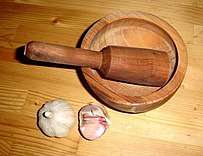

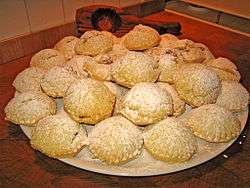
_(cropped).jpg)